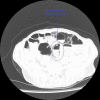An unusual triad of pneumatosis intestinalis, portal venous gas and pneumoperitoneum in an asymptomatic patient
- PMID: 25858266
- PMCID: PMC4390992
- DOI: 10.1093/jscr/rjv035
An unusual triad of pneumatosis intestinalis, portal venous gas and pneumoperitoneum in an asymptomatic patient
Abstract
Pneumatosis intestinalis (PI) is defined as the presence of gas within the serosal or mucosal layer bowel wall. This sign is usually found upon radiographic imaging and is most commonly secondary to acute gastro-intestinal ischaemia. Fifteen per cent of cases can present with a primary condition called pneumatosis cystoides intestinalis (PCI). PCI is usually a benign condition and patients are usually asymptomatic. Portal venous gas (PVG) or the presence/accumulation of free gas within the hepatic portal vein. It is most commonly associated with acute bowel ischaemia, and when seen in the presence of ischaemia the mortality rate is between 75 and 90%. Other associations include mechanical causes (e.g. obstruction), chemotherapy, liver transplant and diverticulitis. Benign PI has previously been described with PVG, but usually in the presence of other associated conditions such as AIDS, malignancy or chemotherapy. Some examples have been described without these associations, but not with free intra-peritoneal air. We describe a case of PCI and PVG with pneumoperitoneum, investigations and ongoing management.
Published by Oxford University Press and JSCR Publishing Ltd. All rights reserved. © The Author 2015.
Figures



References
-
- Wiesner W, Mortele KJ, Glickman JN, Ji H, Ros PR. Pneumatosis intestinalis and portomesenteric venous gas in intestinal ischemia: correlation of CT findings with severity of ischemia and clinical outcome. AJR Am J Roentgenol 2001;177:1319–23. - PubMed
-
- Wayne E, Ough M, Wu A, Liao J, Andresen KJ, Kuhen D, et al. Management algorithm for pneumatosis intestinalis and portal venous gas: treatment and outcome of 88 consecutive cases. J Gastrointest Surg 2010;14:437–48. - PubMed
-
- Galandiuk S, Victor W, Fazio A. Pneumatosis cystoides intestinalis. Dis Colon Rectum 1986;29:358–63. - PubMed
-
- St. Peter SD, Abbas MA, Kelly KA. The spectrum of pneumatosis intestinalis. Arch Surg 2003;138:68–75. - PubMed
Publication types
LinkOut - more resources
Full Text Sources
Other Literature Sources
Research Materials
Miscellaneous

